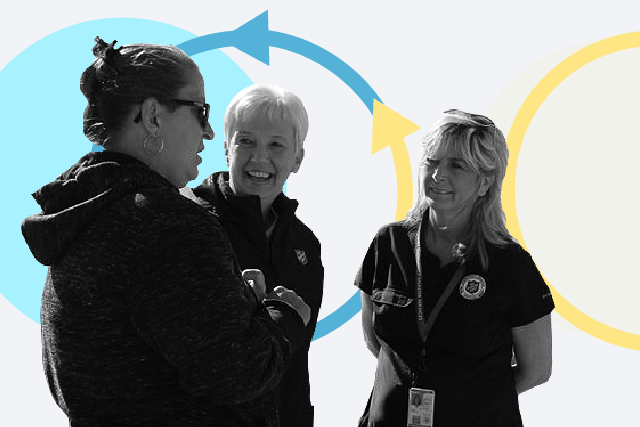A human-centered approach to government
We’re working to design, build, and manage public service delivery through the moments that matter in peoples’ lives – not our bureaucratic silos
The Federal Government interacts with millions of people each day and provides vital services during some of the most critical moments in people’s lives. Whether searching for vaccine safety information, claiming retirement benefits, receiving health insurance, passing through a security checkpoint, or checking the status of a farm loan application, Americans expect Government services to be responsive to their needs. But too often, people have to navigate a tangled web of Government websites, offices, and phone numbers to access the services they depend on.
The “life experience” organizing framework requires a new model of the Federal delivery system working together—within agencies, across agencies, even across levels of government — driven by customer (human-centered design) research (both quantitative and qualitative), rather than within bureaucratic silos, to solve problems.
In Summer 2021, the Biden-Harris Administration’s first update to A-11 Section 280 included a new role for the President’s Management Council (PMC) to identify a limited number of cross-agency life experiences for collective effort. Building on this, the President’s Management Agenda (PMA) Vision released in November 2021 identified the improved management of cross-agency life experiences as a strategy to improve Federal service delivery and customer experience. Finally, Executive Order 14058 on Transforming the Customer Experience and Federal Service Delivery to Rebuild Trust in Government provided additional details on the role of Executive Office of the President leadership, accountability structure, and ongoing cadence to support the management of designated cross-agency life experiences.
Life Experiences
-
New in 2022
Having a child and early childhood for low-income families

There were 3,605,201 births in the United States in 2020. 42 percent of these were covered by Medicaid. With almost a quarter of all workers having a child under five, this life experience impacts millions of Americans.
-
New in 2022
Navigating transition to civilian life

Separating service members face reorienting their civilian lives around key domains, including: education, employment, health, finance, housing and social relationships, but quantitative and qualitative data suggests that around half of all recently separated Veterans may not connect with available resources, benefits, services and tools for several years.
-
New in 2022
Approaching retirement

Social Security benefits and Medicare are two of the bedrock federal programs in the United States, almost universally enrolled. Yet, irrespective of income, education level, and race, navigating retirement claiming timing and Medicare enrollment processes are time consuming, confusing, complex, and often require back-and-forth with these two programs.
-
New in 2022
Facing a financial shock

Because of complex and burdensome application and payment systems, millions of American families miss out on help getting food, health insurance, and other supports to build better lives for themselves and their children when facing a financial shock like an unexpected medical bill, the loss of income, raise in rent or loans coming out of deferment.
-
New in 2022
Recovering from a disaster

Those who have lived through a natural disaster are facing one of the most difficult experiences they’ve ever encountered: attending to their families’ most basic needs while experiencing trauma, stress, and multiple bureaucratic processes. In these most vulnerable moments, survivors expect the government to step up.
-
Transitioning to adulthood (2020)

People with an intellectual disability and their families interact with agencies and organizations at the Federal, state, and local level year after year. It can be incredibly difficult to understand the full scope of what programs are available, who to go to for what, and to weave together the right supports; all at different life stages.
-
Recovering from a disaster (2020)

Those who have lived through a natural disaster are facing one of the most difficult experiences they’ve ever encountered: attending to their families’ most basic needs while experiencing trauma, stress, and multiple bureaucratic processes. In these most vulnerable moments, survivors expect the government to step up.
-
Seeking employment after service (2020)

Each year, approximately 200,000 service members leave the military. Employment statistics have continued to improve, but there is more to understand to improve the rates of those that find a career that is satisfying, has potential for development and higher wages, and recognizes valuable skills veterans have.
Mapping Life Experiences

What is a journey map and how do you read it?
Journey maps serve as a summary of voices of actual people and represent their experiences at points along a series of steps across some time period. When reading a journey map, the actions at the core of the image show high-level steps along the journey, while the other elements reveal research insights that can inform opportunities for improvement.

What is the purpose of a journey map?
The Federal Customer Experience team, led by the Office of Management and Budget, partnered with 10+ agencies for a human-centered approach to improving critical moments in our customers’ lives. The research and production of these maps can help to align our collective understanding of how a service delivery system is experienced by the public. Through identifying common barriers, we can improve coordinating efforts across the Federal government.

How will this journey map be used?
Although it’s difficult to re-design complex delivery systems, specific barriers along a journey can indicate areas that matter most to the people we serve. The journeys above show that more broad interagency efforts (e.g., on “veterans employment”) can be slower to deliver changes than scoped challenge areas (e.g., “better connecting job searching platforms”). We plan to form interagency design teams that convene experts to prototype and test solutions for streamlining services.
Journey Map: Surviving a Natural Disaster
Journey Map: Transitioning to Adulthood
Journey Map: Seeking Employment after Service
Service Member Transition to Civilian Employment, Journey Map Guide
Service Member Transition to Civilian Employment, Project Report
Service Member Transition to Civilian Employment, Workshop Guide for Federal Agencies
How we used data from our interviews (information collection approved under OMB Control # 2900-0876)
How we used data from surveys (information collection approved under OMB Control # 3090-0321)
